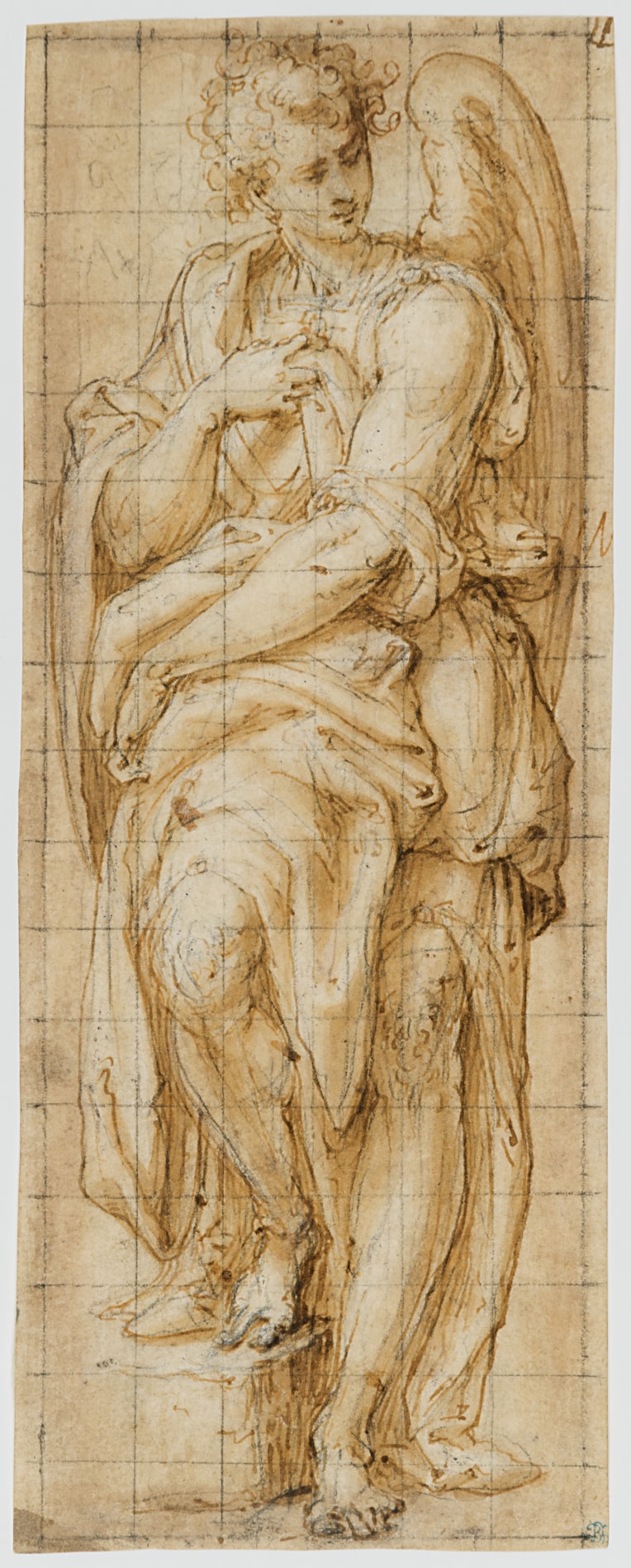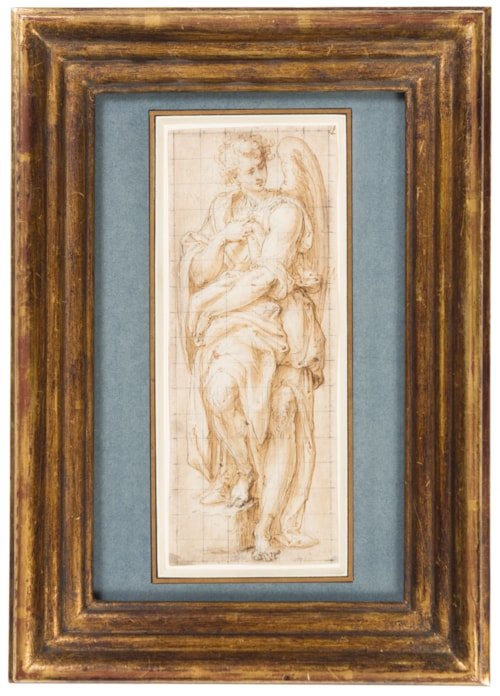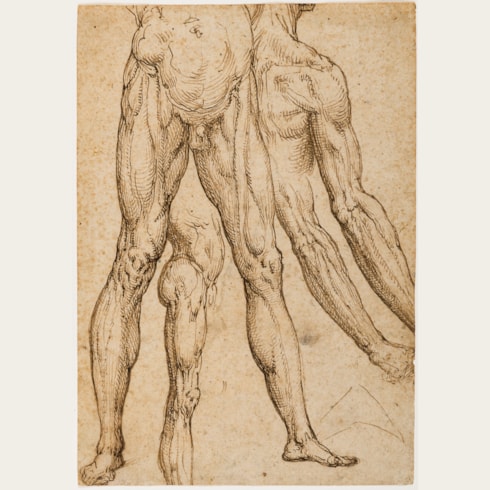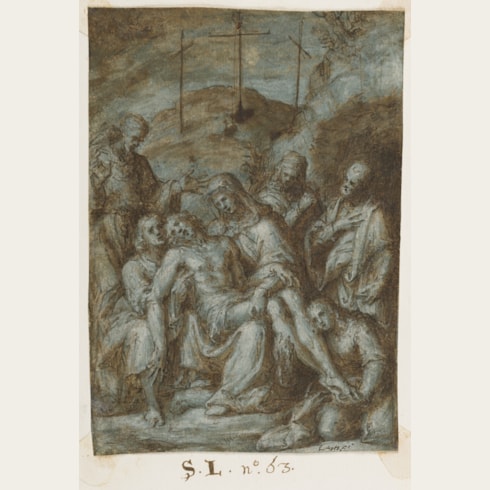Aurelio LUINI
(Milan c.1530 - Milan 1593)
Study of an Angel
Sold
Pen and brown ink and brown wash, heightened with white, over an underdrawing in black chalk.
Squared for transfer in black chalk.
A faint study of a leg and foot in black chalk on the verso.
213 x 83 mm. (8 3/8 x 3 1/4 in.)
Squared for transfer in black chalk.
A faint study of a leg and foot in black chalk on the verso.
213 x 83 mm. (8 3/8 x 3 1/4 in.)
The present sheet, squared for transfer, is a preparatory study for Aurelio Luini’s altarpiece of The Baptism of Christ, painted c.1570-1575, in the parish church of Santi Giacomo and Brigida in the town of Cassago Brianza in Lombardy. Following tradition, the Baptism takes place in an open landscape by the river Jordan. At the centre, Christ rests his left knee on a rock while being baptised by his cousin, Saint John, who stands at the right. At the left, four angels gather to witness the event. This drawing, which also carries a light silhouette of a right leg on the verso, relates closely to the standing angel in the left foreground of the Baptism. The pose of the angel in the present sheet, resting his right foot on a stone - thus echoing the pose of Christ – and holding his tunic with both hands, is virtually identical to that in the painting. Slight variations between drawing and painting, such as the tilting of the angel’s head and the height of his wing, are the result of adjustments made by the painter directly on the canvas.
Technically, this study displays the typical traits of Aurelio’s graphic style at its best, from the confident use of pen and ink to the carefully modulated chiaroscuro, down to signature traits, such as the flying curls and gnarled fingers and toes. The drawing’s high level of finish, emphasised by the combined use of brown wash and white heightening, together with the presence of squaring for transfer, indicate that Aurelio was approaching the final stage of the preparatory process, just prior to the cartoon. Given the grace and refinement of this drawing, it comes as no surprise that it was preserved in the workshop for future re-use. A preliminary sketch by Luini for the figures of Christ and Saint John the Baptist in the Cassago Brianza canvas was on the art market in Paris in 1985, while another preparatory study for the same two figures appeared at auction in Milan in 1979.
Together with his brother Giovan Pietro, Aurelio Luini had previously frescoed a Baptism of Christ on the dividing wall of the church of San Maurizio al Monastero Maggiore in Milan in 1565. The painting at Cassago Brianza recalls that composition, although it depicts four angels at the left rather than three, and omits God the Father surrounded by angels at the top. Aurelio’s oeuvre of drawings includes various studies of angels - such as the two full-size cartoons of Angels Holding Curtains in the Biblioteca Ambrosiana in Milan - which epitomise his virtuoso skills as one of the most talented draughtsmen of the late Milanese Renaissance.
The first recorded owner of the present sheet was Count Giacomo Durazzo (1717-1794), a noted Italian diplomat and one of the most important print collectors of the 18th century, who served as both the Genoese ambassador at the court of Vienna and the Austrian ambassador in Venice. This drawing later entered the collection of Boguslaw Jolles (d.1912), who was active in Dresden and Vienna in the last quarter of the 19th century. Jolles began collecting drawings in the 1870s, and continued to do so over the next two decades. The present sheet was one of several works acquired at the 1895 sale of Jolles’s collection by the German lawyer Dr. Michael Berolzheimer (1866-1942). Berolzheimer’s collection of some eight hundred prints and drawings was confiscated by the Nazis and sold at auction in Munich in 1939, a year after the collector had emigrated to America.
We are very grateful to Dr. Lucia Tantardini, who has established the attribution of the Cassago Brianza canvas to Aurelio, and for confirming the direct rapport between our drawing and the painting, of which she has also kindly provided a photograph.
Technically, this study displays the typical traits of Aurelio’s graphic style at its best, from the confident use of pen and ink to the carefully modulated chiaroscuro, down to signature traits, such as the flying curls and gnarled fingers and toes. The drawing’s high level of finish, emphasised by the combined use of brown wash and white heightening, together with the presence of squaring for transfer, indicate that Aurelio was approaching the final stage of the preparatory process, just prior to the cartoon. Given the grace and refinement of this drawing, it comes as no surprise that it was preserved in the workshop for future re-use. A preliminary sketch by Luini for the figures of Christ and Saint John the Baptist in the Cassago Brianza canvas was on the art market in Paris in 1985, while another preparatory study for the same two figures appeared at auction in Milan in 1979.
Together with his brother Giovan Pietro, Aurelio Luini had previously frescoed a Baptism of Christ on the dividing wall of the church of San Maurizio al Monastero Maggiore in Milan in 1565. The painting at Cassago Brianza recalls that composition, although it depicts four angels at the left rather than three, and omits God the Father surrounded by angels at the top. Aurelio’s oeuvre of drawings includes various studies of angels - such as the two full-size cartoons of Angels Holding Curtains in the Biblioteca Ambrosiana in Milan - which epitomise his virtuoso skills as one of the most talented draughtsmen of the late Milanese Renaissance.
The first recorded owner of the present sheet was Count Giacomo Durazzo (1717-1794), a noted Italian diplomat and one of the most important print collectors of the 18th century, who served as both the Genoese ambassador at the court of Vienna and the Austrian ambassador in Venice. This drawing later entered the collection of Boguslaw Jolles (d.1912), who was active in Dresden and Vienna in the last quarter of the 19th century. Jolles began collecting drawings in the 1870s, and continued to do so over the next two decades. The present sheet was one of several works acquired at the 1895 sale of Jolles’s collection by the German lawyer Dr. Michael Berolzheimer (1866-1942). Berolzheimer’s collection of some eight hundred prints and drawings was confiscated by the Nazis and sold at auction in Munich in 1939, a year after the collector had emigrated to America.
We are very grateful to Dr. Lucia Tantardini, who has established the attribution of the Cassago Brianza canvas to Aurelio, and for confirming the direct rapport between our drawing and the painting, of which she has also kindly provided a photograph.
The youngest son of the Milanese painter Bernardino Luini, who died when he was an infant, Aurelio Luini nevertheless worked in his father’s tradition as a pupil and one of the most accomplished followers of Leonardo da Vinci. Like his father, Aurelio worked throughout his life in and around his native city of Milan, often in collaboration with other local artists. Together with his brother Giovan Pietro, he was tasked with completing some of the fresco decoration begun by their father Bernardino in the Milanese church of San Maurizio al Monastero Maggiore. In this cycle of scenes from the life of Christ, his first major independent work, Aurelio’s forms retain his father’s characteristic softness and chiaroscuro. Many of the younger Luini’s commissions came from religious societies, and his work can be found in several churches in Milan, including San Simpliciano and the Duomo. He also produced numerous fresco cycles in the city and throughout Lombardy and Piedmont, notably in the church of Santa Maria di Campagna in Pallanza, on Lake Maggiore, where he worked alongside the painter Carlo Urbino. Among Luini’s final and most significant works were the now-lost frescoes of scenes from the life of Saint Ambrose for the vault of a chapel in the Tribunale di Provvisione in Milan, completed a few weeks before his death in 1593. As well as being a painter, Luini also composed music and poetry, and was himself the subject of a sonnet written by artist and theorist Giovan Paolo Lomazzo, who regarded him as the most gifted of Bernardino’s Luini’s three sons: ‘Evangelista and [Giovan] Pietro [Luini] are equal in painting, but you are more worthy, Aurelio, whose mind has higher aspirations, as one can see and admire in your work. Besides, with the lyre singing sweetly you reveal your thoughts and your drawings in ornate and worthy verses.’
Aurelio Luini was a talented draughtsman, and the only one of the three Luini brothers to have a recognizable drawing style. One contemporary source, writing two years after Aurelio’s death, noted of him that ‘Il Louino fù gran disegnatore, & acurato pittore, e versato in molte altre honorate virtù, il che universalmete era amato da tutti, e nella pittura fù vero imitatore del padre.’ He tended to work in pen and ink, sometimes with wash on blue paper, with a confident and nervous manner. Drawings by Luini are fairly rare, and only some two hundred are known.
Aurelio Luini was a talented draughtsman, and the only one of the three Luini brothers to have a recognizable drawing style. One contemporary source, writing two years after Aurelio’s death, noted of him that ‘Il Louino fù gran disegnatore, & acurato pittore, e versato in molte altre honorate virtù, il che universalmete era amato da tutti, e nella pittura fù vero imitatore del padre.’ He tended to work in pen and ink, sometimes with wash on blue paper, with a confident and nervous manner. Drawings by Luini are fairly rare, and only some two hundred are known.
Provenance
Count Giacomo Durazzo, Vienna and Venice (according to the 1895 Helbing catalogue)
Boguslaw Jolles, Dresden and Vienna (Lugt 381 or 381a)
His sale, Munich, Hugo Helbing, 28-31 October 1895, lot 122 (as Simone Cantarini: ‘Engel nach links stehend. Sammlung Durazzo. H. 21,2, B. 8,2 cm. Prächtige Feder- und Bisterzeichnung, weiss gehöht. Quadrirt.’)
Michael Berolzheimer, Untergrainau, nr. Garmisch-Partenkirchen
His (anonymous) sale, Munich, Adolf Weinmüller, 9-10 March 1939, lot 141 (as Cantarini: ‘Stehender Engel. Feder u. Bister, quadriert. 21,5 : 8,5. Ehem. Sig. Durazzo. Sz. Bog. Jolles.’)
Anonymous sale, Stuttgart, Ketterer, 24 November 1954, lot 388 (as Cantarini, bt. Landolt)
Robert Landolt, Chur
Thence by descent.
Boguslaw Jolles, Dresden and Vienna (Lugt 381 or 381a)
His sale, Munich, Hugo Helbing, 28-31 October 1895, lot 122 (as Simone Cantarini: ‘Engel nach links stehend. Sammlung Durazzo. H. 21,2, B. 8,2 cm. Prächtige Feder- und Bisterzeichnung, weiss gehöht. Quadrirt.’)
Michael Berolzheimer, Untergrainau, nr. Garmisch-Partenkirchen
His (anonymous) sale, Munich, Adolf Weinmüller, 9-10 March 1939, lot 141 (as Cantarini: ‘Stehender Engel. Feder u. Bister, quadriert. 21,5 : 8,5. Ehem. Sig. Durazzo. Sz. Bog. Jolles.’)
Anonymous sale, Stuttgart, Ketterer, 24 November 1954, lot 388 (as Cantarini, bt. Landolt)
Robert Landolt, Chur
Thence by descent.
Literature
Giovanni Agosti and Jacopo Stoppa, Bernardino Luini e i suoi figli, exhibition catalogue, Milan, Palazzo Reale, 2014, pp.299 and 301, fig.143 (where dated to c.1570).








